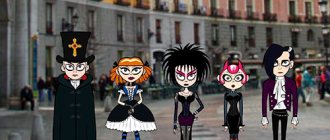If you are asking the question: “What is a subculture?”, then you should pay attention to the fact that this concept is very broad. For the first time, they began to talk about subcultures as a phenomenon in the twentieth century, oversaturated with various philosophical movements. The next century did not stand aside: already well-known youth subcultures began to modernize, acquiring new touches.
The essence of the term
Subculture
is a concept derived from the Latin words “sub” (under) and “cultura” (culture), and is used in sociology and cultural studies. We are talking about a part of society that differs from the overwhelming majority in its worldview and behavior. Carriers of subcultures may differ from other people in their value system, appearance and other aspects.
Youth subcultures have several varieties and are formed on demographic, national, geographical, professional and other bases.
Most often, one or another subculture “marks” its adherents with certain patterns of behavior, features of appearance (clothing, hairstyles), vocabulary and other distinctive characteristics.
History and origin of the term “subculture”
In the 20th century the number of emerging communities united along some basis increased, and then this phenomenon received the name subculture.
The term was coined by David Riesman, an American sociologist, to refer to people who deliberately adhere to minority views. “Sub” means “under”, respectively, otherwise the word is translated as “subculture”.
Today, the concept of “subculture” is actively used in sociology, anthropology and other social sciences.
Types of subcultures
The list of subcultures has several types:
According to musical preferences
Representatives of individual subcultures often prefer different music. Goths like gothic metal, metallists like heavy metal and its types, punks like punk rock, rastafarians like reggae, emo likes post-hardcore and so on.
Sports subcultures
One of the most famous sports subcultures is parkour. The term denotes the masterly art of moving and avoiding obstacles in space. The key idea of parkour: “there are no boundaries, there are only obstacles.” Parkour became especially popular after the release of the films “The Thirteenth District” and “Yamakashi”.
Football fans are also considered a special sports subculture. They became a more organized group at the turn of the 70-80s of the twentieth century.
By style
Among the subcultures that stand out in style are usually noted: Visual kei, military, teddy boys, cyber goths, mods, dudes, freaks. All of them have their own distinctive features in the image.
According to public beliefs
The list of subcultures also includes those that stand out based on their social beliefs: beatniks, SHARP skinheads, RASH skinheads, straight edgers, anarcho-punks, yuppies, informals, new age, happy people.
By hobby
People who are united by a common specific hobby and accompanying paraphernalia also consider themselves to be one of the subcultures. We can talk about the following communities: bikers, reenactors, gamers, b-boys, role-players, and so on.
By hooligan behavior
The greatest fears among ordinary citizens are representatives of precisely these subcultures, similar in their hooligan and defiant behavior: ultras, highly organized lyubers, ore boys, football brawlers, and gopniks.
According to other signs
There are many youth subcultures united by other hobbies. Among them are otaku - people who adore and are well versed in anime and various manga. Also quite remarkable are furries who are fans of anthropomorphic creatures and consider themselves part of the furry fandom.
Youth subcultures and their role in modern society
Time flies quickly and the world adapts to its changes. However, there have always been those who considered it necessary to adhere to their chosen ideology, challenging the majority of those around them. In the twentieth century, such individuals united under the term “subcultures” and actively continue to develop their communities.
Initially, representatives of such groups opposed themselves to the majority in every possible way and were reluctant to accept newcomers into their ranks. Now there is much more freedom in this regard. In the Soviet Union they were called an informal youth association. They were viewed with disapproval and fear, but now subcultures no longer seem unusual, scary or unhealthy.
They are no longer considered something categorically negative, and even bring some benefit to society. Now people who previously kept to themselves, afraid of being misunderstood, can easily find friends with similar interests, no matter what crazy hobbies interest them.
Members of various subcultures are often teenagers who want to protest to adults, and if their choice falls on gopniks and emo, this can lead to problems.
Positive and negative aspects of subcultures
Despite the wary attitude towards them, subcultures, in general, are useful for the development of society.
Many people have hobbies that are incomprehensible to most. Subcultures are an opportunity to communicate in an environment close to them. Often this is the only way a person can relax and be in his element. In this sense, the subculture is a unique and expanded continuation of the tradition of a club of interests.
Subcultures play an important role in the socialization of people who do not fall into accepted standards or who have serious unpopular hobbies.
This becomes dangerous at the moment when the subculture begins to preach antisocial, immoral values. In isolated groups, the influence on each member increases and it is much easier to instill a destructive idea in a person.
Based on the above, it is clear that it is impossible to judge all subcultures equally. Each pursues its own goals and has its own views, so they can only be assessed individually.
List of subcultures
The list of subcultures is quite extensive. Let's look at the most popular of them. So, examples of subcultures
Hippie
A philosophical youth subculture, the first mention of which appeared in the 60s in America. Initially they protested against Puritan morality and violence. They were also called "flower children" for using the slogan "Flower Power". One of the symbols of the group were old painted minibuses, in which they drove around small cities in the United States, shocking their fellow citizens with their unusual appearance and extraordinary antics.
Hippie clothing is dominated by ethnic elements and rich colors. They often wear long hair and are fond of Eastern religions and meditation. According to their beliefs, people should be free, and this can be achieved by changing the soul.
Skinheads
An ultra-right youth subculture, whose members are distinguished by very extreme activities and promote National Socialist ideology. Appeared in England in the 80s of the twentieth century. They positioned themselves as soldiers of the Holy Racial War, opposing “subhumans” - Jews, African Americans, gypsies, homosexuals, drug addicts, left-wing youth. After the collapse of the USSR, the movement began to gain popularity in Russia, taking on an extreme direction. Skinheads have a personality cult of Hitler and other Nazis. They are supporters of radical measures against “non-Aryans”.
The image of a typical skinhead: shaved head or short hair, dark T-shirts or shirts, dark jackets, high boots.
Emo
A fairly well-known example of a subculture. Typically, it includes teenagers with a pronounced emphasis on personal experiences, sublime friendship and love, and romanticism. They are guided by spiritual ideals in the form of honesty, sincerity, and fidelity. Appeared in Britain in the 80s of the twentieth century.
Popular paraphernalia: badges on clothes, bags, shoes, as well as large jewelry, glasses with bright frames. The image is dominated by black and pink colors. Black symbolizes rejection and depression, while pink symbolizes denial of a dark reality. Emo are often vulnerable and depressed, and have suicidal tendencies (artificially cultivated or real).
Goths
They represent a youth subculture that appeared in the 70s of the twentieth century. The name appeared a little later, but the exact meaning and authorship are unknown. It is assumed that the term came from the meaning of “barbaric” or from the nickname of the leader of the group “Sex Gang Children” (Count Weezy-goth). The subculture was formed as a musical one, but later literature (Mary Shelley, E. Poe, etc.) and cinema (“Sleepy Hollow,” “The Raven,” etc.) had a significant influence.
The main aspects of the image: the predominance of black clothing, metal jewelry, Gothic symbols (skulls, crosses, pentagrams, and so on). Makeup is used by both women and men (white powder, black eyeliner).
Punks
An example of a subculture that almost everyone has heard of. The word “punk” comes from the English “punk” (garbage, dirt). The movement began in the USA, Canada, and Great Britain in the 70s. Representatives of the subculture are distinguished by their desire for independence, anti-militarism, nihilism, and personal freedom. There are many branches of the movement (horror punk, Nazi punk, and so on).
Typical look: bright hair tied into a mohawk. They often wear leather jackets, stained jeans, sneakers, and heavy boots. They use decorative cosmetics. Well-known attributes of the subculture: bracelets, spiked collars, earrings.
Rastafarians
Representatives of a subculture advocating the religious and political doctrine of African superiority. The basis of beliefs is the idea of the return of blacks to Africa and the creation of a huge African state. In the CIS there was a replacement with the idea “Zion is in you”. The beliefs of Rastafarians say that Zion must be sought not in the material world, but in the human soul, striving for it with good deeds, thoughts, and love.
Preferred colors are red, green, yellow, music is reggae, hairstyle is dreadlocks. They believe that hashish and marijuana should be allowed to the population at the official level and participate in various demonstrations.
Gamers
The term comes from the English word “gamer” (player). We are talking about a person who is addicted to computer games and feels psychologically dependent on them. Infatuation can lead to unfavorable consequences: a person ceases to adequately perceive reality. Gamers are not only a youth subculture; both children and older people can be drawn to games.
With the spread of Internet technologies, the subculture began to spread more actively. Outwardly, gamers may not differ from their peers, but their “essence” is easy to detect when communicating: they know a lot of terms related to the life of a gamer that are incomprehensible to most people. The benefits of such a hobby are possible only if there is a sense of proportion. A person who does not sit at games all day long develops the speed of thinking, his reactions become sharper.
Gopniks
This term first appeared in the 80s of the last century. It was characterized by a youth subculture that did not disdain criminal antics, defiant and impudent behavior. Features of an ordinary gopnik: the desire to instill fear, humiliate, dominate. According to many researchers, a significant layer of modern young people can be classified as gopniks.
The behavior of a representative of a “gopota” is indistinguishable from the behavior of ordinary criminals. They are aggressive and often spend time on the streets, “clinging” to passers-by. A characteristic appearance that has become the subject of numerous memes: duck cap, sweatpants, leather jacket, shoes or sneakers. Strongly expressed homophobia is natural for representatives of this stratum.
Roleplayers
Not the most famous, but growing youth subculture. Adherents of role-playing games understand that it is not easy to seriously change the world around them, so they create “their own reality”, immersing themselves in the world of fantasy and various games. In the modern world, we can distinguish several main trends in this area: hobbit games, Satanic role-playing games, fantasy Rosicrucians.
Relationships between different subcultures
Subculture is a very common phenomenon, divided into types, each of which has its own characteristics and differences. Like other cultural phenomena, subcultures were formed in a culturally saturated environment. This happened at the beginning of the twentieth century, during a period of oversaturation of society with various ideas and philosophical movements. In the modern world, it is impossible to say that subcultures are autonomous and in no way connected with others. They have to interact, and conflicts often arise in their relationships.
Some subcultures openly declare hostility to each other's worldview. This is called subcultural antagonism. We can talk about musical subcultures and, accordingly, conflicts arise as a result of differences in preferences. The situation became especially noticeable when many musical styles, significantly different in sound and style, began to become popular in society. Each subculture believes that their genre is better and has depth, unlike others.
The tension that arises between the parties can lead to confrontation between the participants. Each subculture tries to honor its own unspoken rules. Often they are not even prescribed, but appear intuitively. In similar situations, representatives of different subcultures can act completely opposite, depending on their worldview and motivation. Any association adheres to its own value system, and, naturally, considers the opinions of other informal groups not entirely correct or completely absurd. In the event of a clash in such a situation, it is difficult to reach an agreement. For example, skinheads do not consider it shameful to seek their own righteousness by going through physical violence. At the same time, emos are not at all prone to violence and can even sacrifice their lives to prove the truth of their own beliefs.
The main task of society is to recognize that a subculture is part of the general culture. It is not at all necessary to use the usual radical measures, trying to prove the significance of your opinion and your own rightness. Many parents worry about their children becoming part of a subculture, but when it comes to something as innocuous as clothing styles, allow your teen to express their individuality. Many young people are trying to express their protest by joining one group or another - show them that you are on the same side with them and there is no need to oppose each other.
Subculture concept
On one of the Internet sites there is a list of common phrases of a modern person, for which in 1990 a person was threatened with ending up in a psychiatric hospital. For example, “I’ll call you back from the forest.” Another example: in a bookstore, up to two-thirds of books have titles and genres that were impossible a couple of decades ago.
In the lives of teenagers, boys and girls, young people, these socio-technical innovations and cultural influences take shape in the form of modern youth subcultures and activities.
Subculture is patterns of behavior, lifestyles, specific values and their symbolic expression of a social group.
Not only age cohorts and special layers of youth, but also professional groups have their own subcultures. Doctors, astronauts, actors, TV people, teachers have subcultures... The usual teacher words “window”, “clock”, “rusichka”, “extension” are not understood by all representatives of other professions. Try to decipher the slang of TV journalists: “brick”, “canned food”, “live”, “ruler”, “parquet”... Distinctive cultural features are also inherent in political associations: the subculture of the same communists is not very similar to the subculture of liberals.
Youth subculture is patterns of behavior, clothing styles, musical preferences, language (slang), specific values and their symbolic expressions characteristic of groups of young people (12−25 years old).
Youth subcultures have existed for a long time, at least since the second half of the twentieth century. In our country, they attracted the attention of society and the media in the 1980s. In those years, bearers of such special cultural practices were usually called participants in informal youth associations. The most famous examples are hippies, punks, rockers, and metalheads.
The main socio-psychological feature of informal youth associations is the symbolization of appearance, lifestyle, behavior, in particular, clothing, speaking style. For example, long hippie hair is not only long hair, but also a symbol of freedom; the English-language layer of hippie slang is an orientation toward Western patterns of behavior; an apartment where informal people gather is not just a room, but a flat, where everyone is their own, united by an unpretentious style of everyday life.
Gromov Dmitry Vyacheslavovich, candidate of psychological sciences “Youth subcultures”
The predominant orientation of those youth and youth groups was asocial. Asocial, but not antisocial! Asociality in this terminology is interpreted as non-acceptance of the norms of appearance, behavior, communication, and pastime prevailing in official society. While antisociality is the orientation of an individual, a group that contains an aggressive principle opposing society and tends to merge with a criminal culture.
The number of young people, teenagers belonging to youth subcultures 15–20 years ago, even in big cities, was small. According to a number of surveys in the early 1990s, 1-3% of boys and girls definitely considered themselves to be informal groups.
In the 2000s, significant changes occurred and are occurring in youth culture. First of all, this is the increase, the growth of youth groups, united by new, sometimes very unusual, activities, such as role-playing games (role-playing games), mountbacks, fire shows, photo crosses, city games (watches, encounters, quests), parkour, street dances, street balls, graffiti, paintballs, bikers, stretchers. Some of these groups, the same bikers and racers, significantly go beyond the youth age.
Sometimes a subculture of its own arises around such activities: its own clothing traditions (the same cap for mountain bakers or the gloves of fire fighters), its own idols, gathering places, traditions, rules of “hanging out.” But often young men and teenagers, getting carried away by new activities, do not perceive themselves as belonging to any special group. For them, activity is just activity.











